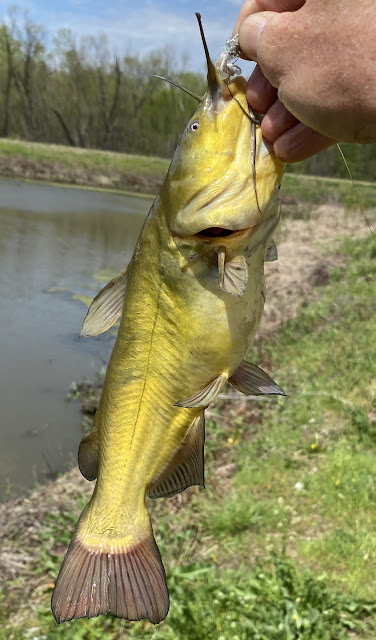***I haven't shared much regarding techniques for quit a while, my recent posts being more about the fish with which I am so enamored. I'm going to start sharing more specifically what I've learned for the various species I've caught.
We all know fish in different waters can behave differently and have different preferences. But I think overall this will give folks who want to try for certain species more info that can hopefully get them started off on the right foot, rather than going blindly. We can all shorten our personal learning curve by first learning from the experience of others.***
This blog post is about Bullhead.
 |
| Bullhead on Fly |
Bullhead are comprised of a number of species, the 4 most common perhaps being Black Bullhead, Brown Bullhead, Yellow Bullhead, and White Catfish. The full range of these encompasses much of the eastern 2/3 of the U.S.
Of these 4, I've only caught Black Bullhead and Yellow Bullhead, as far as I can tell.
They can be found in rivers, lakes, and ponds.
They are largely omnivorous like a common carp, but likely eating more aquatic larvae and worms, and even small fish. They do have a very large mouth for their size, so they will eat whatever they can fit in.
Where I fish, I catch Bullhead most often during the warmest months of the year. I don't know what they do when it gets colder, but I just don't see or catch them then.
As you might expect, I feel it helps immensely if the water is clear enough for sight-fishing....where you can present the fly to an individual fish or spot, and see how they react. But most often I'm fishing stained water, sometimes churned up by the bullhead themselves as they search for food.
They do seem to like feeding along rocky shorelines. They will feed just under the surface at times, but most often are feeding near the bottom.
Although I've caught a number of them by blind casting, if I can see them, I will present a fly directly to them. I will cast beyond them, then swim the fly back close to them. Sometimes they will detect it and lunge for it, other times if you can just put it in front of them, they will eat first and figure it out later.
I've caught them on GameChanger flies and other patterns, but by far my best technique has been to suspend a microjig under an indicator, and cast parallel to a shoreline, and retrieve it very slowly, with long pauses between strips. They will take the indicator down!
The microjigs I use most for them are from 1/80th oz ot 1/64th oz, #8 hook. Color doesn't seem to matter at all. The indicator I prefer is the Original size Fish Pimp brand strike indicator.
They don't get particularly big, usually, and they aren't particularly strong fighters. Bullhead can be enjoyed on 3wt-5wt fly rods. I use a weight forward floating line, and tippet should be 4lb-8lb Fluorocarbon.
Handle Bullheads with care, as the spines in there dorsal and pectoral fins can poke you. It stings, but they are not poisonous. Also, don't lip them like a bass. They have very rough tooth pads on their jaws, and a VERY strong bite force. They WILL clamp down on your finger!
Bullhead are very challenging, interesting, and fun. I really enjoy catching them on flies. They are a native fish that needs to be appreciated. Do some research, find some fish near you, and get after them! Good luck!
Here's some pics of Black Bullhead and Yellow Bullhead I've caught while flyfishing:






















No comments:
Post a Comment